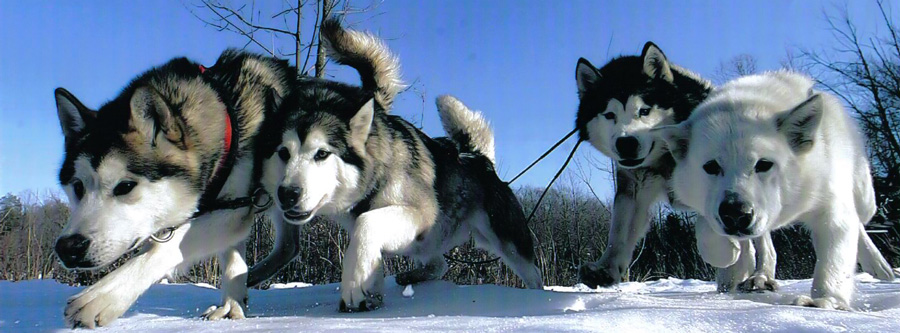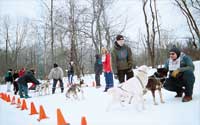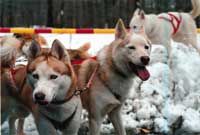Sled dog racing is a great spectator sport. No snow potatoes allowed! Onlookers are recruited as sled holders and dog handlers. Others just come to learn more about dogs.

As mushers and their dogs break out of the starting chute in the "last great race," the Iditarod in Alaska, dog sled teams are racing across Northwest New Jersey. Alaska's 1,100 miles of frozen tundra, rivers and mountains from Anchorage to Nome are home to the even-paced Iditarod, but New Jersey's high speed, short-distance sprint races are run on the hilly narrow trails of High Point State Park.
Before dawn, loaded vans and trucks with dog boxes pull into the frozen parking lot off Sawmill Road. In the silence, doors swing open and mushers unload the dogs. Siberian Huskies, Alaskan Huskies, and even Dobermans and mixed breeds with Greyhound, long and lean with aerodynamic faces, are chained to long poles bolted alongside the trucks between the bumpers or to cables spread between the trees.
The dogs are quiet in the hours before race time. They know what the day will bring.

There are separate races for teams with eight dogs, six dogs, four dogs, three, and a general Sportsman race for recreationists, a Junior for kids, and a Pee Wee race for tiny mushers with a parent running alongside with a connecting line to the one-dog team. The course for each class differs in length, roughly one mile per dog.
Ten minutes before the race, the timing crew synchronizes watches. The starter performs the countdown at the chute. As each class is called by the Race Marshall, the teams line up at the chute. Each team has one minute from the scheduled race time to get at least 100 yards past the chute. But first they have to get to the chute - the driver and the sled hooked to the gangline with up to eight yelping, jumping dogs. Each team has dog handlers who run alongside and hold the collars of the dogs to control them, as the they make their way to the chute. The dogs are coiled tight as springs.

"One minute." The handlers restrain the dogs. Two sled holders stand with one foot propped against each runner to keep the dogs from ripping out of the icy chute. The driver walks calmly to the head of the team and pets the dogs with hugs and whispered words of encouragement, lead dog first, then down the line to the wheel dogs. Pep talk time. "Thirty seconds." The dogs know the countdown. They leap in their harnesses, straining to run, to pull, to speed down the trail. "Fifteen seconds." The handlers brace against the dogs' excitement, careful not to quell their spirit. Some dogs squat their hindquarters in the snow, like human runners, ready to leap. "Ten, nine, ...... Go Driver!" The handlers, the sled holders, the spectators, all jump back as the once-howling, straining, leaping dogs zoom down the trail. They are silent now, engrossed and happy in their task, doing what sled dogs are built for.

The teams barrel down the trail. The dogs scan the crosstrails as they run, tongues flying sideways. Spit covers their faces. Drivers call to the dogs "Straight Ahead! Good Dogs!" They fly silently by. The beauty of the running dogs and the focused driver, a team in unison, one purpose, working together, is sheer perfection. Words of praise and encouragement pepper the run. "Good Boy!" "Good Girl!" Even "Mommy's Big Baby!" They issue commands--"Gee!" for right, and "Haw!" for left, and the incredible "On By!" for "ignore whatever's around you." The dogs understand. As they take the last turn at the top of the snowy stretch, they call to the dogs words that will make them fly. "Let's Go Home!" or "Go Get Daddy!"
Through the day peaceful excitement reigns as teams get ready to run and others cross the finish line. Competition and camaraderie co-exist. Drivers pet their dogs, feed them, groom them, and take them for walks to socialize with spectators and other mushers. Conversations of racing and living with dogs abound. The exchange of ideas speeds the time and fills the spaces for mushers between the races.
On Sunday, racing fever peaks. Party attitude fills the air and everyone is happy, including the dogs. The timers calculate speeds over two days of racing and winners take the purse.
It's been a long wait for a snow race in New Jersey--twenty years. So when 22 inches fell in High Point last February, mushers from all over the mid-Atlantic region rallied to the snow race sponsored by the New Jersey Sled Dog Club (NJSDC), one of the state's three sled dog clubs. According to Kathy Murarik, race marshall and president of NJSDC, the last snow race in New Jersey was in 1980 because there's been no snow on the appointed race day since then. Since 1990, the club planned a race in the New York Catskills, and every year it was cancelled, until the white fluff fell in '94. Then, in 1995, the idea to race at High Point was conceived, and races were annually planned and canceled until 2000, when it finally snowed.
The hard-packed race trails of High Point have their own special flavor. They follow the course of a wide, tarred and chipped road through deciduous forest, with cross-trails on grass and stone. There are lots of turns and ups and downs. On both race days last year, trail conditions were hard-packed, fast and slightly icy.
Murarik says that what makes High Point special is its loop-trail system. Most other trails are "out and back," and you'd have to go to the Mid-West to find loop trails.
The first mile out of the chute was a downhill, and for John Miller of Hainesville, it was an easy run for his team of five Malamutes. Miller and his dogs enjoy the narrow trail with overhanging branches that rises along a swamp.
Mushers from South Jersey, used to driving a three-wheeled gig on the sandy flats of the Pine Barrens, loved the snow race. The biggest difference Mike Whitby noticed about his first snow race was the quiet. Without the usual rattle and bumps of a gig, all he heard was the sliding noise of the sled going across the snow. "It made me feel free. I didn't see anything but the white and the trees."
Jan Haring has been running dogs for 15 years, and has only been in two snow races. Used to the flats of South Jersey, she called part of the 3-Dog trail she ran "Cardiac Hill," but said it was a beautiful race. The woods were gorgeous, and the hills and turns were interesting to her dogs. "All I heard was the whoosh of the runners and the breath of the dogs. It's tranquil."
The New Jersey Sled Dog Club was founded in 1978 by a group of people who loved dogs and wanted to race. Club dogs include Siberian Huskies, Alaskan Huskies, Samoyeds, Labrador Retreivers and German shepherd crosses. Club people are as varied as their dogs, from all walks of life. Most members live in the Skylands, but others come from Pennsylvania and Long Island. The club holds gig and sled races and skijoring. As an ongoing part of public relations and community awareness, the NJSDC performs demonstrations for elementary schools, parks, and organizations including Liberty State Park's Science Center. The NJSDC meets twice a year, but many of its members train together from October through March on local trails, dirt roads, and old railroad beds on State lands. As part of its commitment to the State park system, the club maintains a multi-use trail in High Point State Park. Anyone interested in the NJSDC can contact Kathy Murarik, President, at 973-633-2164 or check the website.